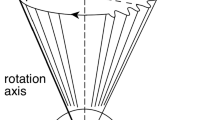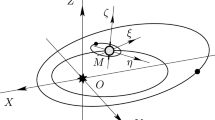Abstract
The work is devoted to the study of the physical libration of the Moon. Interest in the traditional topic related to the rotation of the Moon is stirred up by the activity of many countries regarding the development of circumlunar space. Scientifically, the main agenda is to consider the viscosity of the core. At this stage of the theory development, such effects as indirect and direct perturbations from the planets were considered, the 4th order harmonic was included in the gravitational potential of the Moon, and the mean tidal potential was also considered. The inclusion of the described effects in the equations of the Moon’s rotation led to a significant improvement in the solution when compared with the corresponding data from the DE421 theory, although the residual differences still remain greater than the 1 ms accuracy required by the theory. The influence of the direct effect from the planets was milliseconds. The influence of the 4th harmonic manifested itself as a systematic shift of the order of 0.85\('' \) in the residual differences in libration in longitude. Considering the tide made it possible to reduce the residual differences in latitude by almost an order of magnitude. In this case, the main factor that reduces the residual differences is changes in the second-order Stokes coefficients. The calculations were carried out using the DE421 ephemeris built at NASA Jet Propulsion Laboratory.






Similar content being viewed by others
REFERENCES
A. A. Zagidullin, N. K. Petrova, V. S. Usanin, Y. A. Nefed’ev, and M. V. Glushkov, Uch. Zap. Kazan. Univ., Ser. Fiz.-Mat. Nauki 159, 529 (2017).
N. Petrova, Earth, Moon Planets 73, 71 (1996).
R. C. Weber, P.-Y. Lin, E. J. Garnero, Q. Williams, and P. Lognonne, Science (Washington, DC, U. S.) 331, 309 (2011).
R. F. Garcia, J. Gagnepain-Beyneix, S. Chevrot, and P. Lognonné, Phys. Earth Planet. Inter. 188, 96 (2011).
A. S. Konopliv, R. S. Park, D.-N. Yuan, S. W. Asmar, et al., J. Geophys. Res. Planets 118, 1415 (2013).
N. Rambaux and J. Williams, Celest. Mech. Dyn. A-stron. 109, 85 (2011).
J. Williams, D. Boggs, and W. Folkner, JPL Interoffice Memorandum (Internal Document) (Jet Propuls. Lab., California Inst. Technol., Pasadena, CA, 2013), p. 19.
J. G. Williams, D. H. Boggs, C. F. Yoder, J. T. Ratcliff, and J. O. Dickey, J. Geophys. Res. Planets 106 (E11), 27933 (2001).
C. F. Yoder, Phil. Trans. R. Soc. London, Ser. A 303, 327 (1981).
J. O. Dickey, P. Bender, J. Faller, X. Newhall, et al., Science (Washington, DC, U. S.) 265, 482 (1994).
H. Hanada, K. Heki, H. Araki, K. Matsumoto, et al., in A Window on the Future of Geodesy, Proceedings of the International Association of Geodesy General Assembly, Sapporo, Japan, June 30–July 11, 2003, Ed. by F. Sansò (Springer, Berlin, Heidelberg, 2005), p. 163.
N. Petrova and H. Hanada, Solar Syst. Res. 47, 463 (2013).
M. C. Gutzwiller, The Motion of the Moon as Computed by the Method of Hill, Brown, and Eckert (US Government Printing Office, 1986).
Yu. Barkin, H. Hanada, K. Matsumoto, S. Sasaki, and M. Barkin, Solar Syst. Res. 48, 403 (2014).
N. Petrova, Y. A. Nefedyev, A. Zagidullin, and A. Andreev, Astron. Rep. 62, 1021 (2018).
J. Chapront, M. Chapront-Touzé, and G. Francou, Astron. Astrophys. 387, 700 (2002).
P. Bretagnon, Astron. Astrophys. 114, 278 (1982).
D. B. Taylor, S. A. Bell, J. L. Hilton, and A. T. Sinclair, Tech. Rep. (Naval Observ., Washington DC, 2010).
Y. V. Barkin, in Interactions between Physics and Dynamics of Solar System Bodies, Proceedings of the International Astronomical Sypoisum, Pléneuf-Val-André, France, June 21—28, 1992, Ed. by E. Bois, P. Oberti, and J. Henrard (Springer, 1993), p. 404.
E. Bois, I. Wytrzyszczakz, and A. Journet, Celest. Mech. Dyn. Astron. 53, 185 (1992).
J. G. Williams and D. H. Boggs, J. Geophys. Res. Planets 120, 689 (2015).
Funding
This work was supported by the Russian Science Foundation, project no. 20-12-00105 (according to this project, a method for data analysis was developed and numerical calculations were performed). The work was carried out in accordance with the Program of the Government of the Russian Federation on the competitive growth of the Kazan Federal University. This work was partially supported by a scholarship of the President of the Russian Federation for young scientists and graduate students SP-3225.2018.3, a grant from the Russian Foundation for Basic Research (project no. 19-32-50108\19 “mol_nr”) and the Foundation for the Advancement of Theoretical Physics and Mathematics “BASIS.”
Author information
Authors and Affiliations
Corresponding author
Additional information
Translated by E. Seifina
Rights and permissions
About this article
Cite this article
Zagidullin, A.A., Usanin, V.S., Petrova, N.K. et al. Physical Libration of the Moon: An Extended Problem. Astron. Rep. 64, 1093–1106 (2020). https://doi.org/10.1134/S1063772921010066
Received:
Revised:
Accepted:
Published:
Issue Date:
DOI: https://doi.org/10.1134/S1063772921010066




